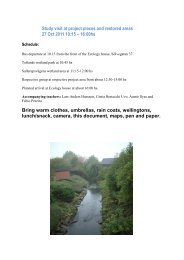Assignment in Hydromechanics (VVR090) (sample problems to be ...
Assignment in Hydromechanics (VVR090) (sample problems to be ...
Assignment in Hydromechanics (VVR090) (sample problems to be ...
Create successful ePaper yourself
Turn your PDF publications into a flip-book with our unique Google optimized e-Paper software.
<strong>Assignment</strong> <strong>in</strong> <strong>Hydromechanics</strong> (<strong>VVR090</strong>)<br />
(<strong>sample</strong> <strong>problems</strong> <strong>to</strong> <strong>be</strong> handed <strong>in</strong>)<br />
1. The discharge conditions <strong>in</strong> a proposed, fairly broad-crested weir with a width B=1.8<br />
m will <strong>be</strong> <strong>in</strong>vestigated <strong>in</strong> a physical model (see figure <strong>be</strong>low). The discharge <strong>in</strong> the<br />
pro<strong>to</strong>type should <strong>be</strong> <strong>in</strong> the <strong>in</strong>terval 5-30 m 3 /s and the weir head H <strong>in</strong> the model should<br />
not <strong>be</strong> smaller than 20 mm (otherwise the discharge will <strong>be</strong> affected by surface<br />
tension). The maximum possible discharge <strong>in</strong> the labora<strong>to</strong>ry is 90 l/s. Determ<strong>in</strong>e the<br />
<strong>in</strong>terval for possible geometric scales λ <strong>in</strong> the physical model, so that the abovementioned<br />
two conditions are not violated. Assume that the discharge from the<br />
proposed weir approximately follows the equation for a sharp-crested, rectangular<br />
3/2<br />
weir: Q= 0.407 2gBH<br />
.<br />
2. A fluid flows out of a conta<strong>in</strong>er through a small, circular tu<strong>be</strong> (see figure on next<br />
page). The average velocity vm <strong>in</strong><strong>to</strong> the atmosphere is assumed <strong>to</strong> depend on the<br />
distance h <strong>to</strong> the liquid surface, the tu<strong>be</strong> diameter d, the acceleration due <strong>to</strong> gravity g,<br />
the density of the liquid ρ, and the dynamic viscosity μ.<br />
a) Show by us<strong>in</strong>g Buck<strong>in</strong>gham’s Π-theorem that:<br />
vm= ⎛ h ⎞<br />
2gh⋅function ⎜Re, ⎟<br />
⎝ d ⎠<br />
hvm<br />
Re =<br />
ν<br />
b) Measurements for a specific water flow from the conta<strong>in</strong>er show that: vm=2.9 m/s<br />
for h=0.7 m when the open<strong>in</strong>g is small (d/h
3. A settl<strong>in</strong>g tank is 10 m long, 3 m wide, and 1.5 m deep (see figure <strong>be</strong>low). The flow<br />
rate Q, conta<strong>in</strong><strong>in</strong>g small particles that should settle, is <strong>in</strong>troduced equally distributed<br />
across the upstream end of the tank and moves with constant velocity <strong>to</strong>wards the<br />
downstream end of the tank, where the flow is discharged. What is the maximum<br />
possible Q if spherical particles with a diameter of 0.5 mm and a density of 1100<br />
kg/m 3 should reach bot<strong>to</strong>m <strong>be</strong>fore the water is discharged from the tank?<br />
4. Water is discharged from a lake <strong>in</strong> a long and 30 m wide channel with a rectangular<br />
cross section and a bot<strong>to</strong>m slope of 1:400 (see figure on next page). The flow rate <strong>in</strong><br />
the channel is 160 m 3 /s. Calculate the water level H <strong>in</strong> the lake if:<br />
a) the Mann<strong>in</strong>g coefficient M=1/n = 80 (smooth concrete)<br />
b) the Mann<strong>in</strong>g coefficient M=1/n = 40 (blasted channel <strong>in</strong> rock)<br />
Consideration should <strong>be</strong> given <strong>to</strong> the <strong>in</strong>let head loss (acceleration loss coefficient<br />
ka=0.25). The hydraulic radius can <strong>be</strong> approximated with the water depth.
5. A channel connects two reservoirs, where the water level of the upper reservoir is<br />
located 1.0 m above the bot<strong>to</strong>m of the <strong>in</strong>let section. At the outlet <strong>to</strong> the lower<br />
reservoir is the water depth 2.0 m. The upper part of the channel is long and the lower<br />
part is short with L2=200 m. The channel cross section has got a rectangular shape<br />
with B=2 m. Further data on the channel is given <strong>in</strong> the figure <strong>be</strong>low. What will the<br />
flow rate Q <strong>be</strong> and where will a hydraulic jump form? What are the water depths<br />
immediately upstream and downstream the jump?<br />
6. The outlet from a settl<strong>in</strong>g tank consists of four sheet metal flumes on the same level<br />
and with horizontal bot<strong>to</strong>ms and <strong>to</strong>p edges. The flumes discharge <strong>in</strong><strong>to</strong> a concrete<br />
collection flume (BC) hav<strong>in</strong>g a free outflow at C and a horizontal bot<strong>to</strong>m, which is 20<br />
cm <strong>be</strong>low the bot<strong>to</strong>m of the sheet metal flumes (see attached figure). The sizes and<br />
locations of the flumes are shown <strong>in</strong> the figure on the follow<strong>in</strong>g page. Calculate the<br />
necessary height of the metal sheet flumes (the same depth for all four of them), if the<br />
flow rate through the settl<strong>in</strong>g tank is 0.12 m 3 /s and the <strong>to</strong>p edge of the flumes should<br />
<strong>be</strong> 0.05 m above the highest water level <strong>in</strong> the flumes.
7. Water is pumped <strong>to</strong> a channel from a reservoir with the water level at +3 m (see<br />
figure <strong>be</strong>low). The pump pipel<strong>in</strong>e is L=50 m long with a diameter of D=0.35 m and a<br />
friction coefficient of f=0.02. The channel has a rectangular cross section with a width<br />
B=0.7 m and a horizontal bot<strong>to</strong>m at the level +2.7 m. There is a weir a short distance<br />
downstream <strong>in</strong> the channel. The water level is assumed <strong>to</strong> <strong>be</strong> horizontal <strong>in</strong> the channel<br />
up <strong>to</strong> the weir.<br />
a) What will the flow rate Q from the pump <strong>be</strong>, if the weir is a sharp-crested one with<br />
the height P=1 m above the bot<strong>to</strong>m?<br />
b) What will the flow rate Q from the pump <strong>be</strong>, if the weir is a sharp-crested 90 o<br />
triangular (Thomson) one with the apex at P=1 m above the bot<strong>to</strong>m? For simplicity,<br />
assume that the weir is fully contracted.
8. A 1500-m long (L) pipel<strong>in</strong>e with a diameter of D=0.2 m and a constant friction<br />
coefficient f=0.020 connects two reservoirs (see figure <strong>be</strong>low). A Venturi meter is<br />
connected <strong>to</strong> the pipel<strong>in</strong>e. What will the read<strong>in</strong>g Δx <strong>be</strong> on the manometer? The<br />
only head losses that arise are due <strong>to</strong> friction <strong>in</strong> the pipel<strong>in</strong>e.













